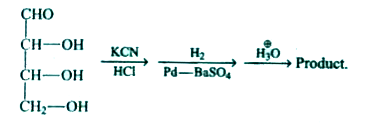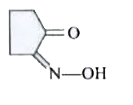H-C ≡ C - H + 2HCl →Final product, final product will be:

CH2=CHCl
CH2∣Cl−CH2∣Cl
none of these
The correct Answer is:A
To solve the question regarding the reaction of an alkyne with 2 moles of HCl, we will follow a step-by-step approach to understand the mechanism and identify the final product.
Step 1: Identify the Reactant
We start with an alkyne, which has the general formula C≡C. Alkynes are characterized by having a triple bond between two carbon atoms.
Step 2: Reaction with HCl
When the alkyne reacts with HCl, it undergoes an electrophilic addition reaction. The HCl dissociates into H⁺ (proton) and Cl⁻ (chloride ion). The alkyne acts as a nucleophile and donates its electrons to the H⁺ ion, leading to the formation of a carbocation.
Step 3: Formation of Carbocation
The addition of H⁺ to one of the carbon atoms of the alkyne results in the formation of a carbocation. The structure of the carbocation can be represented as follows:
- One carbon atom has an H attached, and the other carbon atom has a positive charge (C⁺).
Step 4: Attack by Chloride Ion
The chloride ion (Cl⁻) from HCl then attacks the electron-deficient carbocation, leading to the formation of a vinyl halide. The structure of the vinyl halide will have a double bond between the two carbon atoms, with one of the carbons bonded to a chlorine atom and the other to a hydrogen atom.
Step 5: Second Equivalent of HCl
Now, since we have another equivalent of HCl, the vinyl halide formed can react again with HCl. The process is similar: the vinyl halide will again donate electrons to H⁺, forming a new carbocation.
Step 6: Formation of Germinal Dihalide
The chloride ion will attack this new carbocation, leading to the formation of a germinal dihalide. The final product will have two chlorine atoms attached to the same carbon atom, along with the hydrogen atom on the other carbon.
Final Product
The final product of this reaction is a germinal dichloride, which can be represented as:
- C-Cl
- |
- C-Cl
- |
- H
Thus, the final product is a germinal dihalide (dichloride).
Summary of Steps:
1. Start with an alkyne (C≡C).
2. React with HCl to form a carbocation.
3. Chloride ion attacks the carbocation to form a vinyl halide.
4. React vinyl halide with another HCl to form a second carbocation.
5. Chloride ion attacks the second carbocation to form a germinal dichloride.
We start with an alkyne, which has the general formula C≡C. Alkynes are characterized by having a triple bond between two carbon atoms.
When the alkyne reacts with HCl, it undergoes an electrophilic addition reaction. The HCl dissociates into H⁺ (proton) and Cl⁻ (chloride ion). The alkyne acts as a nucleophile and donates its electrons to the H⁺ ion, leading to the formation of a carbocation.
The addition of H⁺ to one of the carbon atoms of the alkyne results in the formation of a carbocation. The structure of the carbocation can be represented as follows:
- One carbon atom has an H attached, and the other carbon atom has a positive charge (C⁺).
The chloride ion (Cl⁻) from HCl then attacks the electron-deficient carbocation, leading to the formation of a vinyl halide. The structure of the vinyl halide will have a double bond between the two carbon atoms, with one of the carbons bonded to a chlorine atom and the other to a hydrogen atom.
Now, since we have another equivalent of HCl, the vinyl halide formed can react again with HCl. The process is similar: the vinyl halide will again donate electrons to H⁺, forming a new carbocation.
The chloride ion will attack this new carbocation, leading to the formation of a germinal dihalide. The final product will have two chlorine atoms attached to the same carbon atom, along with the hydrogen atom on the other carbon.
The final product of this reaction is a germinal dichloride, which can be represented as:
- C-Cl
- |
- C-Cl
- |
- H
1. Start with an alkyne (C≡C).
2. React with HCl to form a carbocation.
3. Chloride ion attacks the carbocation to form a vinyl halide.
4. React vinyl halide with another HCl to form a second carbocation.
5. Chloride ion attacks the second carbocation to form a germinal dichloride.
Topper's Solved these Questions
- HALOALKANES & HALOARENES BOOK - VMC MODULES ENGLISHCHAPTER - HALOALKANES & HALOARENES EXERCISE - IMPECCABLE
100 Videos
- HALOALKANES & HALOARENES BOOK - VMC MODULES ENGLISHCHAPTER - HALOALKANES & HALOARENES EXERCISE - ENABLE
99 Videos
- ENVIRONMENTAL CHEMISTRYBOOK - VMC MODULES ENGLISHCHAPTER - ENVIRONMENTAL CHEMISTRYEXERCISE - JEE Main (Archive)
39 Videos
- HALOALKANES AND HALOARENESBOOK - VMC MODULES ENGLISHCHAPTER - HALOALKANES AND HALOARENESEXERCISE - IN-CHAPTER EXERCISE - F
6 Videos
Similar Questions
Knowledge Check

Find out final product :A B
B C
C D
D
 Final product Y is:A
Final product Y is:A B
B C
C D
D

Find final product A.APh−CH2−O∣∣C−CH∣Ph−O∣∣C−OC2H5BPh−CH2−O∣∣C−CH2−PhCPh−O∣∣C−CH2−CH2−O∣∣C−OHDPh−CH2−O∣∣C−CH2∣Ph−O∣∣C−OH







